Quiz: Can You Guess a Mineral from a Picture?

Free online printable quiz with multiple-choice questions (MCQ) without registration.
Most minerals are solid materials that are widely used in human activities. They are used to make jewelry, dyes, building materials, and more.
The quiz "Can You Guess a Mineral from a Picture?" consists of 20 interesting questions with hints. Try to look at the image and choose the correct name for each stone. Test your knowledge and visual memory!
Test yourself
Found a mistake? Select it and press Ctrl+Enter
For each question choose one of the multiple answers then click done to check your results.
